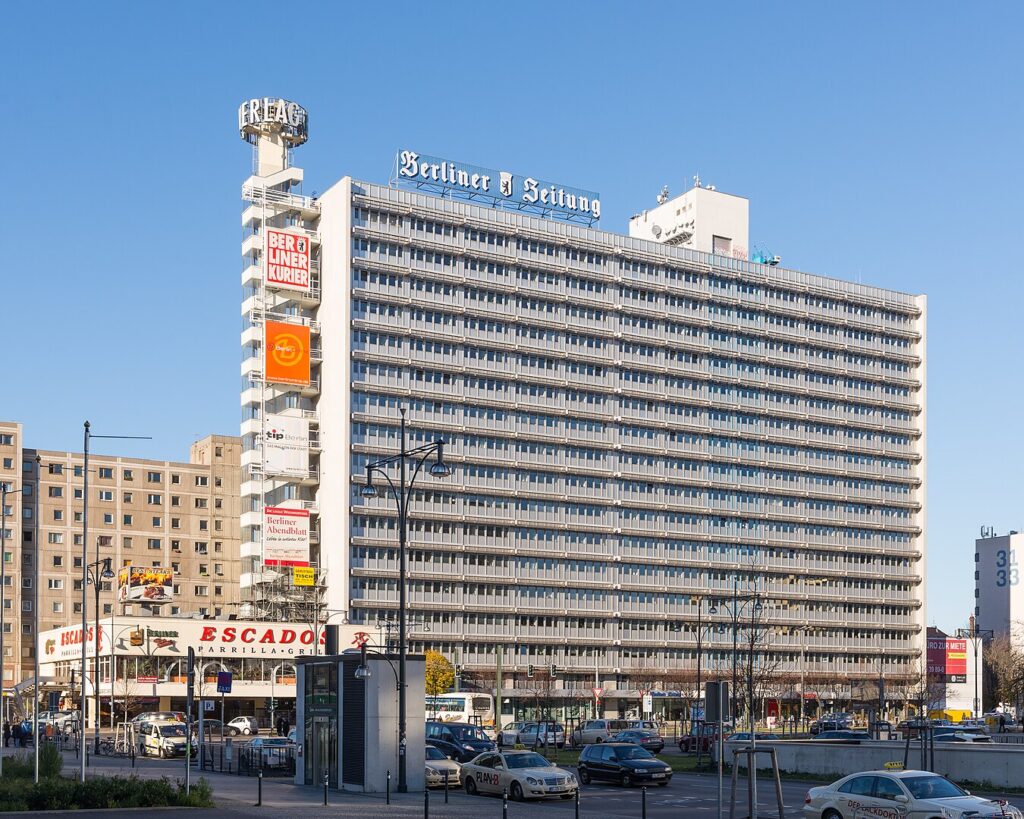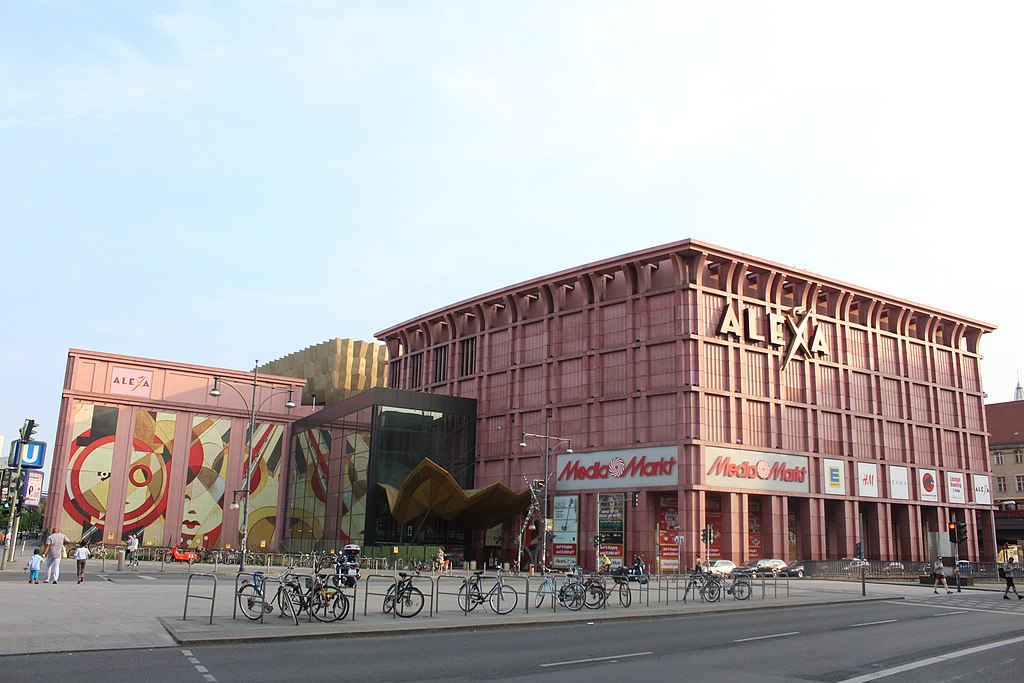Today we’ll complete our excursion around Alexanderplatz. Let’s start by looking at a building very much overlooked by visitors, but which shouldn’t be.
Berliner Verlag
The building is located at 29 Karl Liebknecht Strasse and was the headquarters for the Berliner Verlag, or publishing house, which put out the daily newspaper «The Berliner Zeitung,» which remains the only newspaper published in the Communist east which is still in print today, having pivoted away from an exclusively communist outlook.

The skyscraper was built in the early 1970s and was an answer to a similar structure with a similar purpose in West Berlin. After all, whatever success the west saw, had to be copied and improved in the east. The architecture really evokes the spirit of that era. Notice the staircase, visible from outside the building, running up to the top. Closer to ground level, the original Press Café has been reopened, and the artwork on the exterior restored to their original glory. Feel free to pop inside for a coffee, and to linger in the area, soaking up the atmosphere of the place.
The DDR’s daily paper played a central role in not only sharing the news, but also driving the state’s views and the accepted interpretation of events into the minds of the people. In that sense, this building played a crucial role in forming opinions and driving the populace in the direction the leadership wanted them to go. Little wonder then, that it’s placed so close to the capital’s main square; this building and what its people did mattered hugely to the regime.
Incidentally, the Third Reich placed a similarly high value on propaganda and its role in forming opinion, and their propaganda headquarters occupied a prestigious (and partly surviving) building across the street from the Reichs Chancellery on the Wilhelmstrasse. We can see that here in Berlin, the placement of the news shapers was really of central importance, something to reflect on today, not coincidently.
The East Side
Back on the Alexanderplatz, let’s move down the Bundesstrasse, which is the long street running behind the hotel and which features a long, almost monolithic set of Communist era buildings. Housed here were scientific and technical agencies and shops selling electronic goods among other cutting-edge products. Technology and material progress mattered greatly to the DDR, and so its no surprise that these offices and shops lined this prestigious location.

While you’re here, pop down Bernard Weiss Strasse, named after a famous police commissioner from the Weimar years. Some of you might recognize his name if you’ve seen the Babylon Berlin series or read the so-called Berlin Noir style police and detective thrillers set in Weimar and Nazi Berlin. In the post war years, the distinguished looking building in front you as you stand in the street was converted from its original role as part of a department store warehouse to being the Communist’s police headquarters. Indeed, it’s still the police headquarters today. Again, we see that important buildings ended up on or near the Alexanderplatz, and clearly policing mattered.
Then Stalin Allee – Now Karl Marx Allee
Going back to the square, you’ll see the start of the Karl Marx Allee, the former Stalin Allee, the DDR’s most prestigious road, created from the ruins of the old Petersburger Strasse, which once led to the capital of Imperial Russia, St Petersburg and which, by a small irony, the Russians used as one of their main axes of advance into Berlin in the great battle of 1945. Rebuilt in grand soviet style, it was designed to evoke the equally prestigious Kutuzovski Prospekt in Moscow, but with a German flourish.
The House of the Teachers and the Congress Hall
Head down Otto Braun Strasse now, named after another pivotal figure from 1920s and early 1930s Berlin, and you’ll see the famous House of the Teachers, with its very well-known mosaic decorating the areas above the entrance. This is an original surviving piece from the DDR and showcases the subjects that the East Germans deemed most important for children to learn. The building here is where educational matters were decided, textbooks written, and teacher training programmes designed. As any decent dictatorship understands, if you shape the minds of the young, you shape the future. This was, in other words, yet another centrally important building for the regime.

Next door, from the same late 60s and early 70s era of optimism that characterized the entire square, we see the Congress Hall, a place to hold large gatherings, commemorations and events and well known to every East German citizen for that reason.
The Alexa Mall
Finally, ahead of you on the left, you’ll see looming up the distinctive Alexa Shopping mall. This is certainly not a communist building, but it’s an interesting one for all that. During the DDR, there was a parking lot here. But before that this was the location of the great pre-war police headquarters, known colloquially as «the Alex» or the «Red Castle,» due to its reputation and its formidable appearance, clad as it was in red brick and a not very welcoming atmosphere. If you look, you’ll see that the name of today’s mall is the Alexa, which is one letter away from the old «Alex» nickname. Today’s mall is red and lacks windows, giving it a somewhat forbidding air. This building thus subtly evokes the old Police Presidium building of Prussian, Weimar and Nazi Germany.

It’s worth noting that odd silver pole in the center of the street, mid-way across. That marks the actual location of the original building. The Communists widened the street here dramatically to create another of their wide triumphal streets, so today’s mall actually starts about a third of the way into the footprint of the old building. Again, if you’re a fan of Berlin detective stories, you’ll know that this was the place where every one of the police detectives had their office, facing the train tracks.
Alexanderplatz: Not beautiful – but Lots of History
And with that, we can wrap up our whirlwind tour of the great Alexanderplatz. I hope you’ll now take the time to explore this area and not immediately write it off as ugly and modern, and dash off looking for something older. To do that would be to miss the beating heart of the 20th century’s most important city.




